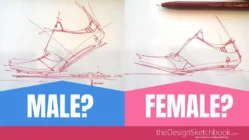
- Start with the Main Shape and Axis
- Use Ellipses to Define Curved Surfaces
- Connect Shapes with Natural Movement
- Trim and Adjust Volumes
- Follow Parallel Lines and Project Details
- Count and Divide Carefully
- Practice Sketching Quickly and Freely
- Maintain Perspective Throughout
- Use Guidelines Effectively
- Transcript
Hello Sketcher!
Today I am in London visiting my friends and student: Vietdong,
He is one of my new beginner student of Sketch Like The Pros.
We are going to do a quick demo giving you
9 sketching tips for beginners, drawing a Power bank. 🙂
Sketching is a fundamental skill every designer must develop, and starting with simple objects helps build confidence and technique. In this tutorial, I partnered with my beginner student Vietdong in London to demonstrate 9 practical sketching tips that will guide you step-by-step through drawing a power bank.
Start with the Main Shape and Axis
We begin by identifying the main shape—the rectangular volume of the power bank—and the axis on the paper. Rotating your paper can make drawing easier and more comfortable. Establishing the symmetry axis between the ellipses at the top and bottom helps you maintain balance in your sketch.
Use Ellipses to Define Curved Surfaces
The power bank has rounded edges, so drawing clear ellipses sets the foundation for smooth, curved surfaces. Starting with the first ellipse, then adding the second one, creates the frame on which you build the rest of the sketch.
Connect Shapes with Natural Movement
Rather than drawing rigid lines, connect forms with fluid, natural movements. This ensures your sketch feels dynamic and lively rather than stiff or mechanical.
Trim and Adjust Volumes
Once the initial shapes are in place, trim the outlines to refine the volume and proportions. Adjusting these shapes allows your drawing to gain accuracy and realism.
Follow Parallel Lines and Project Details
For smaller features like buttons or plugs, follow the direction of existing lines closely. Use perspective projection techniques to align details with the overall form, maintaining consistent depth and dimension.
Count and Divide Carefully
Counting divisions on the sketch helps you position elements like buttons and plugs more precisely. For example, dividing lengths by halves or quarters ensures balanced spacing.
Practice Sketching Quickly and Freely
Don’t worry about perfect lines—sketch quickly to capture the overall idea. Speed helps build confidence and allows you to focus on the essence rather than details.
Maintain Perspective Throughout
Check the perspective carefully, ensuring all dots, edges, and lines align correctly. Proper perspective makes your sketch believable and three-dimensional.
Use Guidelines Effectively
Guidelines—such as diagonal lines or center lines—are crucial until you internalize the proportions. They assist in laying out shapes and keeping symmetry intact.
These 9 tips with Vietdong’s example empower beginners to take control of their sketches, using simple steps to master form, perspective, and detail. Try applying these techniques in your own daily sketching practice and see how your observational skills and drawing speed improve.
Happy sketching!
Cheers,
Chou-Tac
Transcript
Okay. So I’m with VietDong in London, we are going to try, so we start with the main shape.
Yeah. So I turn the paper when I draw.
This is an axis, top of a doodle.
Start with the ellipses.
The second ellipses got done.
And on the paper, I got the natural movement here, so I can just connect. That’s it.
And so we got the main shape here, and I just need to trim it here.
Let’s say I want it like this.
This, then I connect it, and I connect it there.
And I can draw this thing, which is right here, which is exactly parallel.
So I will follow this line, which goes there.
So I will draw something that goes in the same direction, and then I can join.
There’s a small detail here.
So, like, for a small detail, then I can count.
There is like 1, 2, 3, 4, 5, 6. 6 is there. I can divide here by 2.
So basically, I do a diagonal here. I go low. So here’s a middle.
I follow this direction, and I know there are 3 here, 3 here, 3 here, and 3 here.
So basically, the middle is up low.
And then if you want to add this extension that you can plug inside, this is going out from this object, so you may follow these lines. This line here projected to this one. So I’ll take like the reference of this one, and I can just use this detail and project there going in the same direction.
Alright. And then the wire. Let’s see.
That’s just a very quick doodle.
This doesn’t look anything, but the strategy is good. Sketching session with the atom.
Yeah. Alright.
So you turn the paper; go the axis.
So the minor axis is a symmetry axis.
Right? So you connect the two ellipses.
That’s cool. I’m just describing; you know?
Whatever you have to do. I’m just illustrating your action.
So you thank you, Azumi, for sharing.
So yeah, trim the volumes.
Perspective.
Alright. Oh, go ahead.
So make sure that your dots are in perspective as well because of a line.
Take off the… Oh yeah! This line!
Yeah! Correct! That’s it! Yeah! That’s it!
Follow them as a guide! Yeah! Much better.
Okay. Okay. Very good.
Cheers,
Chou-Tac









Add comment